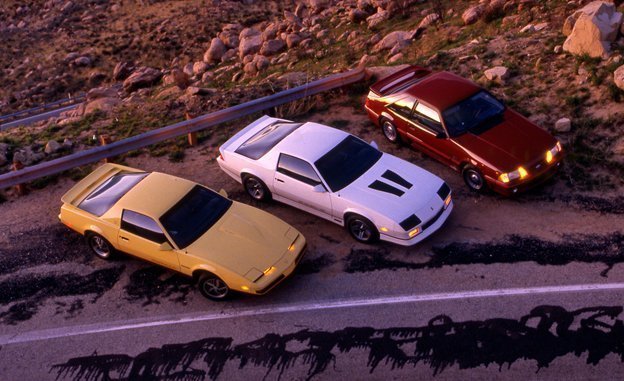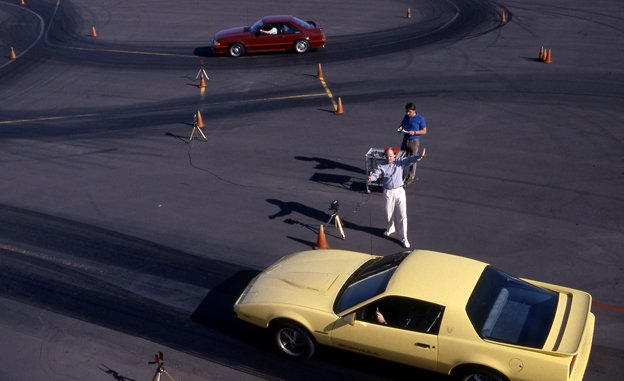 Archived Comparison
From the June 1987 issue
Archived Comparison
From the June 1987 issue
If you think you've seen this show before, sit back, relax, and don't touch that dial. This is no rerun. Just because you can tell the players without a score card doesn't mean you're in for a sleeper. Sparks will fly and spirits will be tested. This is the Celtics versus the Lakers, Army versus Navy, and McEnroe versus just about anybody. Natural enemies have come together again, and they are packing brass knuckles.
Welcome to Car and Driver's annual smoke-'em, slide-'em, rev-'em, go-for-the-jugular American GT comparison test. If you were with us last July, you saw a production-line 4.9-liter Mustang LX whip a prototype 5.7-liter Corvette-engined Camaro IROC-Z upside the head. But that was last year. This is 1987, and it's a whole new street fight.
Only three agitators qualify for this wheel-driven group: the Chevrolet Camaro, the Ford Mustang, and the Pontiac Firebird. You either like these descendants of the original pony cars or you're out of luck, because there are no alternatives. Everything else in this price-and-performance range has a distinctly different flavor.
The faces in this league are pretty much the same as they've been for several years, but in engineering terms there's been a whole lotta shakin' goin' on.
The competition in the pony-car ranks is so keen that yearly improvement has become essential to survival. In 1987 alone, this titanic trio offers one new cost-cutter performance model, three new or improved powertrain combinations, one completely redesigned interior, and one freshened exterior. There are detail improvements as well.

Corporate ego gets much of the credit for this. The Camaro, the Mustang, and the Firebird are high-visibility image leaders, and they have youthful, loyal followings to satisfy. They compete not only in the showroom but also on the street and on the track—and every pony-car engineer worth his bonus wants his brand out front. The Camaro troops feel the same gut rivalry with the Firebird engineers as they do with the Mustang boys.
We know that for a fact, because we invited an engineer from each division to take part in this test. Our instructions were simple: bring the best all-around GT your company can muster. For the sake of equality we specified three-door body styles, but the drivetrains, suspensions, and complements of options were left up to the manufacturer.
GM and Ford mailed us three engineers—all named Jim—and a trio of the most closely matched performance machines America has ever produced. Chevrolet anted up a white Camaro IROC-Z and engineering jack-of-all-trades Jim Hall. Hall (no relation to the Chaparral-driving Texan) is an old friend, having done time on the editorial staffs of Road Test and Motor Trend before deciding to go respectable.
Ford supplied a hot red Mustang in full GT regalia and Jim Kennedy, manager of Mustang development. Kennedy has been ramrodding the aggressive Mustang rejuvenation program since 1982. Just to make sure his days are full, Ford has also put him in charge of the development of the 1989 Thunderbird.
Pontiac sent us a canary-yellow Firebird Formula and hard-charging F-car product-engineering manager Jim Lyons to chaperon it. Lyons's long list of credits includes a central role in the nurturing of the trend-setting 6000STE.
As usual, we ran the contestants through the full battery of C/D performance tests, but we can't emphasize strongly enough that this is not a simple comparison of objective test-track numbers. Cold, hard performance data don't tell you anything about the quality of the driving experience. A skidpad number can't reveal how much satisfaction a car delivers on a mountain road; a 0-to-60 time offers no insight into an engine's refinement in the daily stop-and-go.
No, this is a contest of all-around prowess, focusing on the sum total of pleasure each car delivers in the full range of driving situations—from freeway cruising to autocross flogging. The performance numbers in our data panel are only part of the big picture.
Most important are the subjective impressions we gleaned from our long hours in the saddle. Three C/D scribes took part in this test, and our judgments in ten individual categories are summed up in the Editors' Ratings box. Please note that the Overall Rating scores are not averages of the totals in the nine other categories but independent judgments, with each participant voting his heart.

In addition, we asked our guest engineers to evaluate the three cars in the same ten categories, then tabulated their votes in the Engineers' Ratings box. So that they could pass judgment free from the pressures of corporate politics, we granted them anonymity here. However, their votes did not contribute to the determination of the winner; we deserve all the credit—or blame—for the final results. We also invited the three Jims to write counterpoints, with attribution.
To gather the all-important seat-of-the-pants impressions, we embarked on a two day, 400-mile drive from Los Angeles to the desert community of Palm Springs and back. The route traversed some of Southern California's most challenging two-lane blacktop, including our old favorite, the Ortega Highway (State Route 74 from San Juan Capistrano to Lake Elsinore), and California 243 through Idyllwild and up to Banning.
We finished with an afternoon of autocross competition at the Chrysler Shelby California Development Center in Santa Fe Springs, where the three Bondurant-trained engineers fought the C/D editors tooth and nail for fast time of day. (We aced them in two cars, they beat us in one.)
The three editors and the three engineers named Jim all came to one conclusion: picking the best American GT is tougher than choosing between love and money. In fact, this was the closest-fought comparison test in recent C/D history. But enough tension already. From the bottom, the finishers are . . .